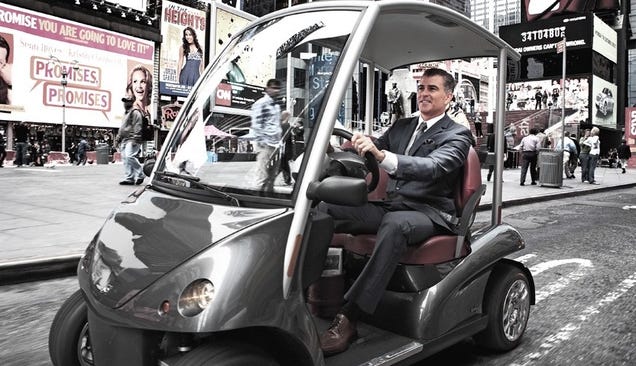Contrary to what the news cycle pounds into our brains, the electric car conversation does not begin and end with Elon Musk. There’s a more affordable and more relevant urban mobility solution than Tesla. I’m talking about the humble golf cart, which is already well on its way to ruling the world.
As Thomas Bartman argues in the Harvard Business Review, Tesla’s electric vehicles are never going to catch on in a big way. The high price point and inability to scale will not help the manufacturer make its way into most of the world’s garages. But more importantly, a flashy, expensive sports car isn’t really necessary for most of the short trips that people are making. True, Tesla’s tracking towards less-expensive cars that might not necessarily be as sporty, but from emissions to safety to cost, low-speed electric vehicles (a fancy way of saying golf carts) make a whole lot more sense in almost every way.
Sure, okay: Lots of cities already use golf carts on college campuses or in airports. Some companies are even using them to make deliveries in particularly dense cities—you’ll see this a lot in Europe. But where they’re seeing the biggest boom right now is in places like China, where the affordable little vehicles are filling an underserved niche: nicer than a motorbike but cheaper than a car. Here’s the Business Review:
In 2013 alone, Chinese consumers purchased over 200,000 low-speed EVs, almost four times Tesla’s cumulative production through 2014, from hundreds of small manufacturers. These sales are overlooked because they take place in small cities, far from the high-profile showrooms of Shanghai and Beijing, but the category is growing rapidly. Low-speed EVs typically sell for half what a comparable combustion-powered car would cost, and because they’re not considered “real” cars, they’re exempted from expensive licensing and registration fees.
This opens the door for another realization: We might not even know how many of these things are currently on the road, because they don’t have to be registered.
Here in the US you can drive street-legal low-speed EVs in some places (in California they’re allowed on streets where the speed limit is 35 mph or under) but in the meantime, lighter and smaller smart cars are closing the gap between traditional cars and the golf cart. Not that they’ll work in every situation: You certainly can’t drive them on a freeway or for longer distances where you just won’t have the range. But they’d work for most daily activities in an urban area.
All these EVs need are some regulatory incentives—maybe they’re allowed on certain streets in high-density neighborhood where cars can’t go—and a little better battery performance. In that way, Tesla is actually helping usher in the age of golf cart domination because it’s helping drive down the price of batteries. And as batteries offer better and better performance for lower and lower prices, those golf carts will take off.

Комментариев нет:
Отправить комментарий